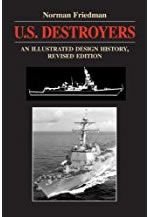USS Thomas (DD-182),
c.1920
|
|
USS Thomas (DD-182) was a Wickes class destroyer that operated on convoy escort duties with the Norwegian Navy in exile as HMS St. Albans in 1942-43 and ended her career with the Soviet navy.
The Thomas was named after Clarence Crase Thomas, the first US naval officer to be killed after the American entry into the First World War, when serving on the merchant ship SS Vacuum.
The Thomas was laid down at Newport News on 23 March 1918, launched on 4 July 1918 and commissioned on 25 April 1919. She joined the Atlantic Fleet and took part in the normal routine of training cruises and fleet exercises before being decommissioned on 30 June 1922.
The Thomas was recommissioned on 17 June 1940 as the US Navy expanded after the outbreak of the Second World War. She joined Destroyer Division 79 of the Atlantic Squadron, and took part in exercises along the US east coast. She was then chosen as one of the fifty destroyers to go to Britain under the 'destroyers for bases' deal, and arrived at Halifax on 18 September 1940. She was decommissioned from the US Navy once again on 23 September 1940 and on the same day commissioned into the Royal Navy as HMS St. Albans (I.15).
As HMS St. Albans
The St. Albans departed for the UK on 29 September and reached Belfast on 9 October. She joined HMS St. Marys (former Bagley DD-185), HMS Bath (former Hopewell DD-181) and HMS Charlestown (former Abbot DD-184) as the escort force for the 1st Minelaying Squadron, operating off the west coat of Scotland. She also took part in some of the earlier minelaying operations in the Denmark Strait between Iceland and Greenland. The St. Albans was also used on convoy escort missions. On 17-18 January 1941, during one of these missions, she helped search for survivors from the SS Almeda Star¸ which had been sunk by U-96 on 17 January.
On 14 April the St. Albans was transferred to the Norwegian Navy in exile, but she almost immediately collided with the minesweeper HMS Alberic, forcing her back to the dockyard for repairs. She then joined the 7th Escort Group, based at Liverpool, and resumed her convoy escort duties. On 12 June she rescued survivors from the Empire Dew, sunk on the same day by U-48.
The St. Albans often operated on the route between West Africa and the UK. On 3 August 1941 the St. Albans, the destroyer HMS Wanderer (D.74) and the corvette HMS Hydrangea (K.39) sank U-401 while escorting Convoy SL.81 from Sierra Leone to the United Kingdom.
On 8 October 1941 the St. Albans was badly damaged in a gale while escorting Convoy ON 22 and had to seek refuge in Reykjavik. In March 1942 she escorted the carried HMS Illustrious from Liverpool to the Clyde for repairs. In April 1942 she escorted Convoy PQ 15 to Russia, helping defend against heavy German air and submarine attacks.
On 2 May 1942 the St. Albans, along with the minesweeper HMS Seagull detected and sank a submarine which tragically later turned out to be the Polish submarine Jastrzab, which had fallen out of position with her convoy and was incorrectly believed to be an attacking U-boat.
Later in May 1942 the St. Albans joined the Liverpool Special Escort Division. One of her tasks was to help escort the RMS Queen Elizabeth from the UK towards the Cape of Good Hope in June 1942, carrying reinforcements for the Middle East. The St. Albans underwent a refit in July-October 1942 then returned to the Special Escort Division for the rest of 1942.
In January 1943 the St. Albans was used as a target ship for Coastal Command training. In February she was part of a force that was sent towards the Norwegian coast to try and find a Norwegian merchant ship that was believed to be attempting to escape to British waters. The St. Albans was attacked by the Luftwaffe during this sortie, but emerged undamaged.
Soon afterwards the St. Albans was transferred to the Western Local Escort Force, based at Halifax, and she spent 1943 escorting convoys in the western Atlantic. On 29 December 1943 she left Halifax for the last time to return to the UK, where she went into the reserve. She was soon reactivated, and on 16 July 1944 was transferred to the Soviet Navy, where she became the Dostoinyi ('Worthy'). She remained with the Soviets until 28 February 1949 when she was returned to British service. She was broken up for scrap at Charlestown, Fife, in April 1949.
Displacement (standard) |
1,160t (design) |
Displacement (loaded) |
|
Top Speed |
35kts (design) |
Engine |
2 shaft Parsons turbines |
Range |
3,800nm at 15kts on trial (Wickes) |
Armour - belt |
|
- deck |
|
Length |
314ft 4in |
Width |
30ft 11in |
Armaments (as built) |
Four 4in/50 guns |
Crew complement |
114 |
Launched |
4 July 1918 |
Commissioned |
25 April 1919 |
Broken up |
April 1949 |
 U.S. Destroyers: An Illustrated Design History, Norman Friedmann .
The standard history of the development of American destroyers, from the earliest torpedo boat destroyers to the post-war fleet, and covering the massive classes of destroyers built for both World Wars. Gives the reader a good understanding of the debates that surrounded each class of destroyer and led to their individual features.
U.S. Destroyers: An Illustrated Design History, Norman Friedmann .
The standard history of the development of American destroyers, from the earliest torpedo boat destroyers to the post-war fleet, and covering the massive classes of destroyers built for both World Wars. Gives the reader a good understanding of the debates that surrounded each class of destroyer and led to their individual features.